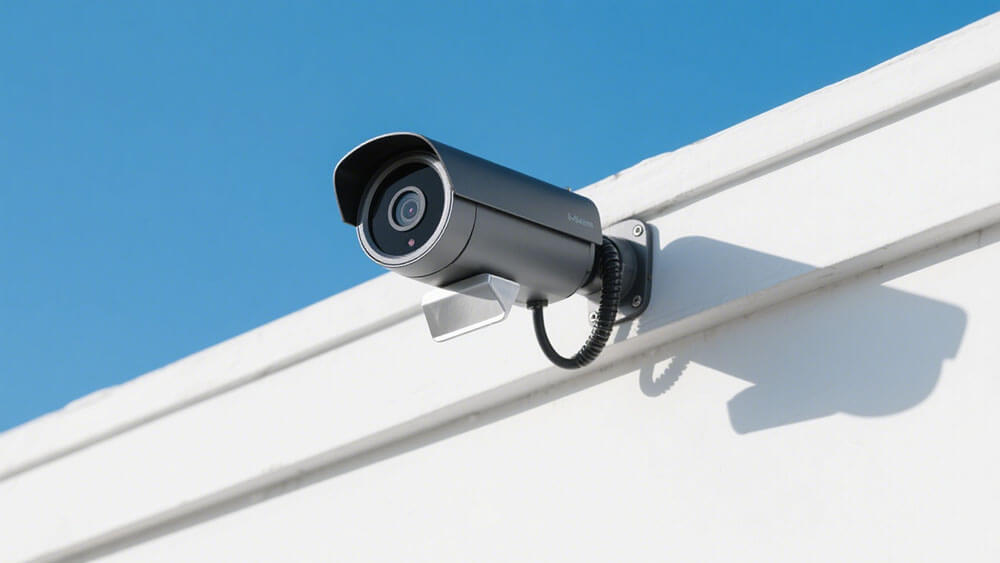
Simple adjustments help you extend battery life in battery-powered security cameras. Adjust motion detection, manage charge cycles, and optimize placement to improve battery life. Disable unused features and reduce video quality for a long-lasting battery. These practices keep battery-powered security cameras reliable and make Lithium Batteries in Outdoor Security Cameras perform better for your business.
Key Takeaways
Manage battery charge cycles by recharging before batteries drop below 20% and avoid full charges over 80% to extend battery life.
Place security cameras in shaded, cool areas with strong Wi-Fi signals and adjust motion detection to reduce unnecessary battery use.
Regularly clean battery contacts, monitor battery health, and replace batteries when capacity drops to keep your security system reliable.
Part 1: Battery Life Importance

1.1 Security and Reliability
You rely on battery-powered security cameras to protect your business assets and property. Consistent battery life ensures your security system operates without interruption. When you extend battery life, you reduce the risk of unexpected downtime. This reliability is critical for businesses that require continuous monitoring, such as warehouses, retail stores, and infrastructure sites. A dependable lithium battery pack keeps your cameras running, even in remote or high-traffic areas. By focusing on ways to improve battery life, you strengthen your overall security posture and minimize vulnerabilities.
Tip: Place cameras in locations with stable temperatures and minimal direct sunlight to reduce energy consumption and help improve battery life.
1.2 Maintenance Reduction
Longer battery life directly impacts your maintenance schedule. Wireless outdoor security cameras can last from one month to six months, depending on recording settings, camera resolution, and activity levels. In high-activity zones, you may need to recharge or replace batteries every few weeks. In low-motion areas, batteries can last up to six months. Frequent battery checks and recharging are common maintenance challenges for businesses. When you improve battery life, you reduce the frequency of these interventions. This not only saves time but also lowers operational costs. Using lithium battery packs with optimized charge cycles further extends battery life and reduces manual maintenance. For businesses with multiple cameras, this means less downtime and more reliable coverage.
Benefits of Longer Battery Life in Security Cameras:
Fewer maintenance visits
Lower labor costs
Increased uptime for security systems
Enhanced reliability for critical infrastructure
Part 2: Lithium Batteries in Outdoor Security Cameras

2.1 Charge Cycle Management
You can extend the lifespan of lithium batteries in outdoor security cameras by managing charge cycles carefully. Frequent, partial charging helps maintain battery health. Avoid letting batteries drain completely before recharging. Lithium battery packs perform best when you recharge them before they reach low levels. This practice reduces stress on the cells and supports consistent operation in demanding environments such as logistics hubs or construction sites.
Tip: Schedule regular charging intervals for your security cameras. This routine prevents unexpected shutdowns and keeps your surveillance system active.
2.2 Avoid Deep Discharge
Deep discharge shortens the life of lithium batteries in outdoor security cameras. When you allow batteries to drop below 20%, you risk damaging the cells and reducing overall capacity. You should monitor battery levels and recharge before reaching critical lows. Many lithium battery packs include built-in battery management systems (BMS), which help prevent deep discharge and protect the battery from unsafe conditions.
Battery Chemistry | Deep Discharge Risk | Recommended Use Case |
|---|---|---|
Lithium-ion | High | Security, retail, logistics |
Moderate | Infrastructure, outdoor | |
High | Mobile, remote sites | |
Low | Critical infrastructure |
2.3 20-80% Rule
You should keep lithium batteries in outdoor security cameras charged between 20% and 80%. Storing batteries at 100% for long periods can accelerate aging. Following the 20-80% rule helps maximize the lifespan of your high-capacity battery and ensures reliable performance. This approach is especially important for businesses that rely on continuous surveillance. You can set alerts or use smart charging features to maintain optimal charge levels.
Best Practices for Battery Storage:
Store lithium batteries in outdoor security cameras at moderate temperatures.
Avoid leaving batteries fully charged or fully discharged for extended periods.
Use battery management systems to automate charge monitoring.
By following these guidelines, you improve the reliability and longevity of lithium batteries in outdoor security cameras across your business operations.
Part 3: Camera Placement

3.1 Avoid Heat and Sun
You should place battery-powered security cameras in shaded areas. Direct sunlight and high temperatures increase energy consumption and shorten battery life. Lithium battery packs operate best in moderate conditions. When you install cameras near HVAC vents or metal surfaces, you risk exposing them to heat. This exposure can degrade lithium-ion and LiFePO4 batteries faster. For industrial or infrastructure sites, select locations with natural shade or use protective covers.
Tip: Monitor temperature data from your camera’s battery management system to prevent overheating and extend battery life.
3.2 Minimize Triggers
Frequent motion triggers drain batteries quickly. You can improve battery life by adjusting motion sensitivity and masking high-traffic zones. In logistics or warehouse environments, set detection zones to focus only on critical areas. This strategy reduces unnecessary recordings and helps extend battery life.
Best Practices:
Lower motion sensitivity in busy areas
Use scheduling to limit recording during low-risk hours
Mask irrelevant zones to avoid false triggers
3.3 Wi-Fi Signal Optimization
A strong Wi-Fi signal reduces the workload on your battery-powered camera. Weak signals force the device to use more power, which shortens battery life. Place cameras within range of your access points. Avoid thick walls or metal barriers that block signals.
Placement Factor | Impact on Battery Life | Recommendation |
|---|---|---|
Wi-Fi Signal Strength | High | Place near access points |
Physical Barriers | Moderate | Minimize obstructions |
Camera Distance | High | Shorten distance to router |
You can use Wi-Fi extenders in large industrial or infrastructure facilities. This approach ensures reliable connectivity and helps extend battery life for all battery-powered security cameras in your network.
Part 4: Maximizing Battery Life with Maintenance

4.1 Clean Contacts
You should clean battery contacts regularly to maintain efficient power transfer in lithium battery packs. Dust, moisture, and corrosion can build up on terminals, causing voltage drops and reducing performance. Use a dry cloth or specialized contact cleaner for this task. In industrial settings, schedule monthly inspections for all security cameras. Clean contacts help you achieve a long-lasting battery and reduce unexpected downtime.
Tip: Always power off your security camera before cleaning battery contacts to avoid electrical hazards.
4.2 Monitor Battery Health
Monitoring battery health is essential for maximizing battery life in outdoor security cameras. You can use built-in battery management systems (BMS) to track charge cycles, temperature, and voltage. Many lithium battery packs provide real-time data through connected dashboards. In logistics or infrastructure applications, set alerts for abnormal readings. Early detection of issues allows you to prevent failures and maintain reliable surveillance.
Monitoring Method | Benefit | Application Scenario |
|---|---|---|
BMS Dashboard | Real-time status | Warehouses, construction |
Manual Inspection | Physical assessment | Remote sites |
Automated Alerts | Preventive maintenance | Retail, logistics |
4.3 Replace When Needed
You should replace lithium battery packs when capacity drops below recommended levels. Aging batteries can cause frequent recharging and unreliable operation. In B2B environments, track battery performance across all devices. Replace units that show signs of swelling, overheating, or rapid discharge. This proactive approach supports maximizing battery life and ensures your security cameras remain operational in critical areas.
Note: Dispose of old lithium batteries according to local regulations. Consider recycling programs to support sustainability.
You can extend battery life in your security cameras by managing charge cycles, optimizing placement, and maintaining lithium battery packs. These strategies help your business reduce downtime, lower maintenance costs, and ensure reliable surveillance. Apply these best practices to achieve long-term performance and peace of mind for your operations.
FAQ
1. How can you choose the best lithium battery chemistry for outdoor security cameras?
Chemistry | Cycle Life | Temp Range | Application Scenario |
|---|---|---|---|
Lithium-ion | 500-1000 | -20~60°C | Retail, logistics, infrastructure |
LiFePO4 | 2000+ | -20~60°C | Industrial, outdoor |
Lithium-polymer | 300-500 | -10~50°C | Mobile, remote sites |
2. What maintenance schedule does Large Power recommend for lithium battery packs in security cameras?
You should inspect battery contacts monthly and monitor battery health weekly. Schedule replacements every two years for optimal performance. Consult Large Power for custom battery solutions.
3. Can you use lithium battery packs in extreme temperatures for security cameras?
You can use LiFePO4 batteries in extreme temperatures. Lithium-ion batteries work best in moderate climates. Always check manufacturer guidelines for your application scenario.




